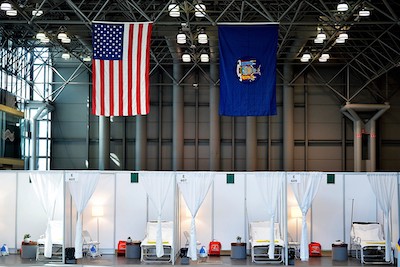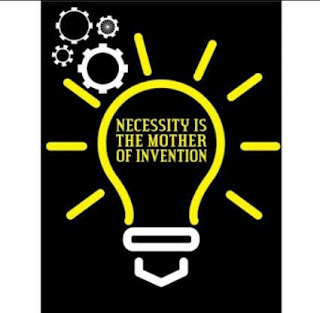Pandemics Are the Mother of Invention
 Kim BellardIf, as they say, necessity is the mother of invention, then you'd have to say that the COVID-19 pandemic is proving to be the mother of invention and innovation. And, Like Isaac Hayes sang about Shaft, it is a "bad mother...(shut your mouth)."
Kim BellardIf, as they say, necessity is the mother of invention, then you'd have to say that the COVID-19 pandemic is proving to be the mother of invention and innovation. And, Like Isaac Hayes sang about Shaft, it is a "bad mother...(shut your mouth)."
Many believe that the Allies won WWII in large part because of how industry in the U.S. geared up to produce fantastic amounts of weapons and other war materials. It took some time for businesses to retool and get production lines flowing, during which the Axis powers made frightening advances, but once they did it was only a matter of time until the Allies would prevail.
Similarly, COVID-19 is making scary inroads around the world, while businesses are still gearing up to produce the number of ventilators, personal protective equipment (PPE), tests, and other badly needed supplies. COVID-19 is currently outnumbering these efforts, but eventually we'll get the necessary equipment in the needed amounts.
Eventually.
What intrigues me, though, is how people are innovating, inventing new solutions to the shortages we face. I want to highlight a few of these: Javits Center hospitalHospitals: China received a lot of press when they built COVID-19 hospitals in a matter of days, and now that is starting to happen here. In New York City, the U.S. current epicenter, the Army Corps of Engineers has, within a matter of days, repurposed the Javits Convention Center into an overflow hospital with almost 3,000 beds, making it the largest hospital in the city. It will serve primarily non-COVID-19 patients, allowing other hospitals to focus on COVID-19 patients.
Javits Center hospitalHospitals: China received a lot of press when they built COVID-19 hospitals in a matter of days, and now that is starting to happen here. In New York City, the U.S. current epicenter, the Army Corps of Engineers has, within a matter of days, repurposed the Javits Convention Center into an overflow hospital with almost 3,000 beds, making it the largest hospital in the city. It will serve primarily non-COVID-19 patients, allowing other hospitals to focus on COVID-19 patients.
Governor Cuomo has set a goal of 1,000 bed overflow hospitals in each of the five boroughs, the other sites being Brooklyn Cruise Terminal, the Aqueduct Racetrack facility in Queens, CUNY Staten Island and the New York Expo Center in the Bronx.
In addition, another field hospital is literally being set up in the field, in this case Central Park's East Meadow, across from Mt. Sinai Hospital. It will have ICU capabilities.
Testing: When this is all over, there will be many analyses about how the U.S. botched coronavirus testing. As of this writing, although testing has become vastly more available, it still is well below what is needed, and we do not have a good understanding of how widespread the virus has spread and who is currently spreading it.
Part of the problem is that, even for those who can get tested, the results can take hours or even several days to get results. During that time, they may be asymptomatic and further spread the virus. All that may be changing. Abbott Labs COVID-19 test.Abbott Labs has gotten approval for a point-of-care test that can give results in as few as five minutes. FDA Commissioner Steve Hahn and former FDA Commissioner Scott Gottlieb both called it a "game changer."
Abbott Labs COVID-19 test.Abbott Labs has gotten approval for a point-of-care test that can give results in as few as five minutes. FDA Commissioner Steve Hahn and former FDA Commissioner Scott Gottlieb both called it a "game changer."
Another game changer is the ability for individuals to self-administer diagnostic tests, alleviating the need to go to testing facilities, and risk exposure for health care workers. A new study has found that such testing can be as accurate as physician-administered tests. Such tests are awaiting FDA approval.
PPE: There similarly are not enough masks and other personal protective equipment. Health care workers are being told to change them after each contact with infected patients, and, as a result, the numbers being used are skyrocketing. President Trump might suspect that something nefarious is going on, but the need is real.
Manufacturing of PPE is ramping up, but it will take time to catch up to need. So Battelle Labs has developed a decontamination system that can allow masks to be reused up to twenty times. It took intervention from Ohio Governor DeWine to persuade President Trump and FDA Commission Hahn to grant FDA approval in a matter of days, but now the system is quickly being ramped up to full capacity.
 Dyson CoVent ventilatorSome hospitals have innovated by using single respirators to serve several patients simultaneously, although the safety of this is unclear. Others are using continuous positive airway pressure machines (CPAPs), more typically used to treat conditions like sleep apnea, although, again, the safety of this is in question.
Dyson CoVent ventilatorSome hospitals have innovated by using single respirators to serve several patients simultaneously, although the safety of this is unclear. Others are using continuous positive airway pressure machines (CPAPs), more typically used to treat conditions like sleep apnea, although, again, the safety of this is in question.Fortunately, the engineers are at it. In Italy, some clever people started 3D printing badly needed respirator values, for free, when hospitals couldn't get them from the original manufacturers.
Never one to be outdone, James Dyson, of vacuum cleaner fame, developed an entirely new ventilator in an astonishing ten days, and is already producing them. Virgin Orbit, which normally, you know, sends things into space, has developed its "mass producible bridge ventilators" and is hoping to begin production in early April, pending FDA approval.
Not to be outdone, within two weeks an MIT team developed an "open source, low cost" ventilator design which it believes can be built for as little as $100 (a normal ventilator costs as much as $30,000). They are waiting for, you guessed it, FDA approval, and warn that these "have to be manufactured according to FDA requirements, and should only be utilized under the supervision of a clinician." In other words, don't try this at home.
---------

These are just a few examples. I didn't discuss, for example, how new treatments and vaccines are being rushed through at a breakneck pace, or the countless innovations front line health care professionals are being forced to come up with every day as they face the crush of very sick, infectious COVID-19 patients.
We are, indeed, at war with the coronavirus, and there are going to be casualties. A lot of them. The number of deaths will shock us. But as shocked as we may become, as overwhelmed as we may feel, we're also going to be amazed at the creativity and innovation people are bringing to the fight. In the end, though, that and the heroics of our health care workers are what is going to win the war.
”Pandemics Are the Mother of Invention" was authored by Kim Bellard and first published in his blog, From a Different Perspective.... It is reprinted by Open Health News with permission from the author. The original post can be found here.
- Tags:
- 3D printing respirator values
- Aqueduct Racetrack facility in Queens
- Army Corps of Engineers
- Brooklyn Cruise Terminal
- Central Park
- continuous positive airway pressure machines (CPAPs)
- coronavirus
- Coronavirus testing
- COVID-19
- COVID-19 hospitals
- COVID-19 pandemic
- COVID-19 patients
- CUNY Staten Island
- Emergency Preparedness and Response (EPR)
- Food and Drug Administration (FDA)
- infectious disease outbreak
- Isaac Hayes
- James Dyson
- Javits Convention Center
- Kim Bellard
- Mt. Sinai Hospital
- New York Expo Center
- non-COVID-19 patients
- open health
- open source
- open source ventilator design
- pandemic
- Personal Protective Equipment (PPE)
- respiratory distress
- Scott Gottlieb
- Steve Hahn
- ventilators
- Virgin Orbit
- Abbott Labs
- Login to post comments